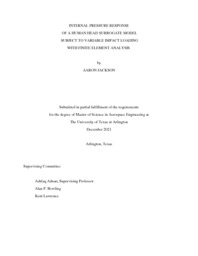
ATTENTION: The works hosted here are being migrated to a new repository that will consolidate resources, improve discoverability, and better show UTA's research impact on the global community. We will update authors as the migration progresses. Please see MavMatrix for more information.
Show simple item record
| dc.contributor.advisor | Adnan, Ashfaq | |
| dc.creator | Jackson, Aaron Ronald | |
| dc.date.accessioned | 2023-06-28T15:25:01Z | |
| dc.date.available | 2023-06-28T15:25:01Z | |
| dc.date.created | 2021-12 | |
| dc.date.issued | 2021-12-21 | |
| dc.date.submitted | December 2021 | |
| dc.identifier.uri | http://hdl.handle.net/10106/31380 | |
| dc.description.abstract | Traumatic brain injury (TBI) from blunt impacts to the head is a major cause of brain disease and dysfunction for thousands of people every year. Each year in the United States approximately 1 million TBI cases occur causing as many as 56,000 deaths and leaving nearly 90,000 individuals with long-term disabilities. Damage resulting from a TBI occurs on a multiscale level including the macroscopic, tissue, and neuron length scale. This research focuses on correlating the macroscopic blunt impact conditions to the internal pressure developed in the coup and countercoup for water and gelatin-filled head models. Two separate 3D printed models are studied: the coronal model simulates a frontal impact and the sagittal simulates a side impact. A dynamic impacting test platform was designed and manufactured in-house to deliver varying controlled impact conditions; impact acceleration and velocity are verified via a rigid body dynamics analytical simulation and digital image correlation (DIC). The coup and countercoup are the measured regions of interest due to the potential for high magnitude transient pressure spikes that may result in cavitation and thus damage the surrounding brain structure. A range of experiments was performed measuring the resulting bulk acceleration and internal fluid pressure response over varying impact conditions for both water and gelatin solutions. The experiment is validated using ANSYS Explicit Dynamics; resulting pressure in the coup and countercoup region are recorded for varying impact velocity conditions. A mesh convergence study was performed for both the coronal and sagittal plane models. The experiment shows that at the maximum impact velocity of 5.5 m/s the coup pressure is approximately +96 kPa while the countercoup is -47.3 kPa. The finite element model shows relatively good agreement with the experimental results for the 5.5 m/s impact condition with a coup pressure of +102 kPa and a countercoup pressure of -68 kPa. | |
| dc.format.mimetype | application/pdf | |
| dc.language.iso | en_US | |
| dc.subject | Traumatic brain injury, Surrogate head model | |
| dc.title | INTERNAL PRESSURE RESPONSE OF A HUMAN HEAD SURROGATE MODEL SUBJECT TO VARIABLE IMPACT LOADING WITH FINITE ELEMENT ANALYSIS | |
| dc.type | Thesis | |
| dc.date.updated | 2023-06-28T15:25:01Z | |
| thesis.degree.department | Mechanical and Aerospace Engineering | |
| thesis.degree.grantor | The University of Texas at Arlington | |
| thesis.degree.level | Masters | |
| thesis.degree.name | Master of Science in Aerospace Engineering | |
| dc.type.material | text | |
| dc.creator.orcid | 0000-0001-9399-7185 | |
Files in this item
- Name:
- JACKSON-THESIS-2021.pdf
- Size:
- 1.439Mb
- Format:
- PDF
This item appears in the following Collection(s)
Show simple item record


